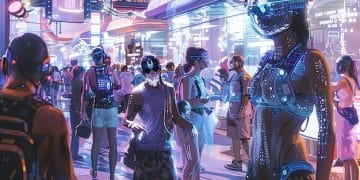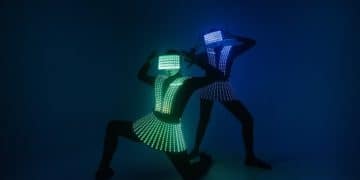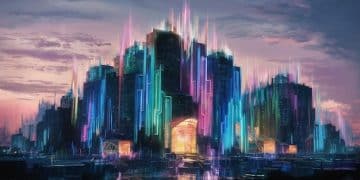Digital Art & Culture Trends in US: What’s Emerging?
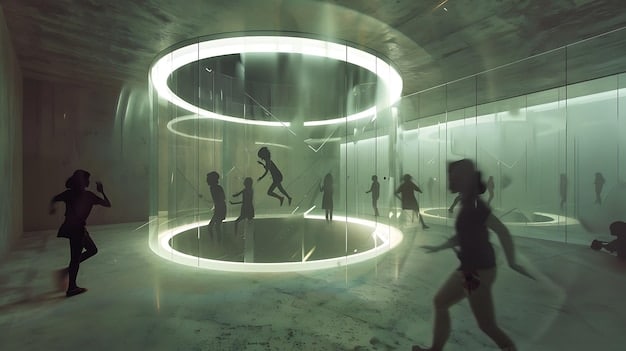
The emerging trends in digital art and culture in the US are rapidly reshaping creative expression and engagement, driven by advancements in immersive technologies, AI integration, and the evolving landscape of decentralized platforms, signifying a profound shift in how art is created, consumed, and valued.
The digital realm has consistently pushed the boundaries of human expression, and today, we witness an unprecedented acceleration in what are the emerging trends in digital art and culture in the US. From virtual galleries to AI-generated masterpieces, the fusion of technology and creativity is not just evolving; it’s revolutionizing how we interact with art and define culture. This exploration delves into the dynamic landscape of these groundbreaking developments, offering insights into the forces shaping the future of artistic and cultural experiences across the United States.
The Rise of Immersive Experiences: VR, AR, and Beyond
The past few years have seen a significant surge in immersive technologies, fundamentally altering how audiences engage with art. Virtual Reality (VR) and Augmented Reality (AR) are no longer confined to gaming; they are powerful tools transforming artistic creation and cultural preservation. These technologies offer a unique blend of physical and digital worlds, creating dynamic experiences that transcend traditional boundaries. Artists are harnessing these platforms to create interactive installations, digital sculptures, and even entire virtual museums that can be accessed by anyone, anywhere, breaking down geographical and logistical barriers that once limited cultural dissemination.
Virtual Reality (VR) in Artistic Expression
VR provides artists with an entirely new canvas, allowing them to sculpt in three dimensions, create environments that defy physics, and invite viewers to step directly into their imaginations. This offers a level of immersion previously unimaginable, where the audience is not just observing art but actively experiencing it. VR art is experiential, often requiring active participation, which fosters a deeper connection between the artwork and the viewer. Museums and galleries are increasingly experimenting with VR exhibitions, making their collections accessible to a global audience and offering novel ways to tour historical sites or explore conceptual artworks.
- Sculpting in Unreal Spaces: Artists use VR headsets and specialized software to create three-dimensional forms that exist only in virtual space.
- Interactive Narratives: VR allows for narrative-driven art pieces where choices made by the viewer can influence the outcome or progression of the artwork.
- Democratization of Galleries: Virtual galleries offer a platform for emerging artists to showcase their work without the need for physical space or traditional gatekeepers.
Augmented Reality (AR) for Public Art and Interaction
While VR transports users to another world, AR overlays digital information onto the real world, enriching our immediate surroundings. This technology has found fertile ground in public art, transforming urban landscapes into interactive exhibits. AR filters on social media, digital murals that animate when viewed through a phone, and interactive historical markers are just a few examples of how AR is making art more accessible and integrated into daily life. This blend of the physical and virtual pushes the boundaries of what public art can be, allowing artists to create temporary or site-specific works without altering the actual environment. It introduces an element of surprise and discovery as users stumble upon hidden digital layers in their everyday routines.
The cultural impact of AR is also significant, as it enables new forms of storytelling and educational content. Historic landmarks can come alive with augmented narratives, providing insights into their past, while cultural festivals can incorporate AR elements to enhance participant engagement. This seamless integration of digital content into our physical perceptions broadens the scope of cultural dialogue, turning ordinary spaces into dynamic canvases for contemporary art and historical reflection. The accessibility of AR through smartphones means that cultural enrichment is literally in the hands of millions.
AI Generative Art and Creative Co-authorship
Artificial Intelligence (AI) is arguably one of the most transformative technologies impacting digital art and culture. Generative AI models are now capable of creating original artworks, music, and even literary pieces, often indistinguishable from human-made creations. This raises profound questions about authorship, creativity, and the role of the artist in an increasingly automated world. Instead of replacing human artists, AI is emerging as a powerful tool for co-creation, enabling new forms of artistic expression and pushing the boundaries of what is aesthetically possible. Artists are leveraging AI algorithms to explore complex patterns, generate new styles, and even overcome creative blocks, viewing AI as a partner rather than a competitor.
The Evolution of AI as a Creative Partner
Early AI art often involved algorithmic generation based on predefined rules. However, modern generative AI, particularly models based on deep learning, can learn from vast datasets of existing art and create novel works that reflect complex aesthetic principles. This ability positions AI not just as a tool for automation but as an entity that can truly contribute to the creative process. Artists are using AI to generate initial concepts, develop variations on themes, or even create entirely new visual languages. The collaboration between human intuition and AI’s computational power opens up avenues for artistic exploration that were previously inaccessible.
For instance, an artist might feed an AI model thousands of images from a specific movement, then prompt it to create new pieces in that style, or even blend styles. This process allows for rapid iteration and experimentation, significantly expanding the artist’s creative output. Furthermore, AI can assist in the technical aspects of art creation, such as optimizing designs for 3D printing or generating complex textures, freeing the artist to focus more on conceptual development. This symbiotic relationship between human and machine is redefining artistic workflow and creative potential.
Ethical Considerations and the Future of Authorship
The rapid advancement of AI in art also brings significant ethical and philosophical discussions to the forefront. Questions about originality, ownership, and copyright become particularly complex when an AI system generates an artwork. Who owns the copyright for AI-generated art? The programmer, the artist who used the AI, or the AI itself? These are uncharted territories that legal and artistic communities are actively grappling with. The potential for misuse, such as deepfakes or copyright infringement through imitation, also demands careful consideration and the development of robust ethical frameworks. The very definition of “art” and “artist” is being re-evaluated in this new context.
The future might see the emergence of hybrid art forms where differentiating between human and AI contribution becomes increasingly difficult, or even irrelevant. The focus could shift from individual authorship to collective intelligence or transhuman creativity. This necessitates a proactive dialogue among artists, technologists, policymakers, and the public to ensure that AI’s integration into art enriches human culture responsibly and equitably. As AI continues to evolve, understanding its implications for creativity and cultural heritage will be paramount.
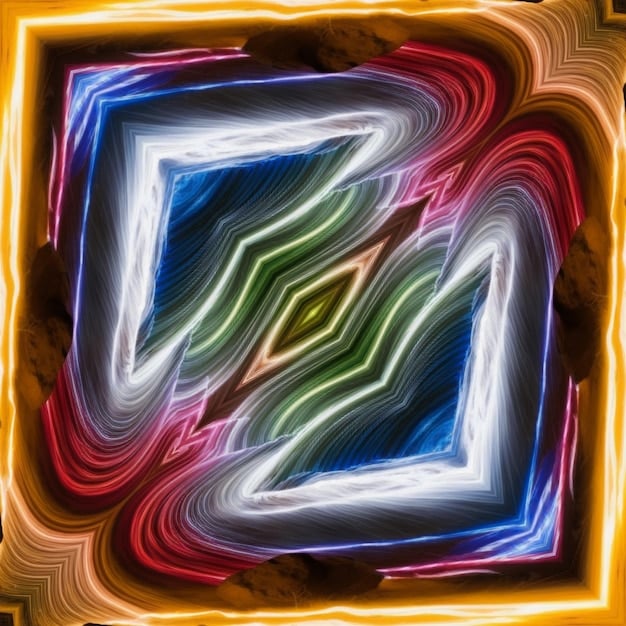
NFTs and the Decentralization of Art Ownership
The explosion of Non-Fungible Tokens (NFTs) over the last few years has dramatically reshaped the landscape of digital art ownership and value in the US. NFTs, unique digital assets recorded on a blockchain, allow for verifiable ownership of digital creations, bringing scarcity and authenticity to something that was previously endlessly reproducible. This technology has empowered digital artists by providing new monetization avenues and direct connections with collectors, bypassing traditional gatekeepers like galleries and auction houses. The cultural impact extends beyond simple transactions; NFTs are fostering new communities, driving experimental art forms, and challenging established notions of intellectual property.
Understanding the Impact of NFTs on Artists and Collectors
For many digital artists, NFTs represent a paradigm shift. Historically, digital art struggled with issues of attribution and value, as digital files could be copied infinitely without any inherent scarcity. NFTs solve this by creating a unique digital fingerprint for each artwork, proving its authenticity and ownership. This has allowed artists to sell their work directly to a global audience, retaining a larger percentage of sales and often receiving royalties on subsequent resales. The financial independence offered by NFTs has spurred a new wave of creativity, encouraging artists to explore digital mediums more deeply.
Collectors, on the other hand, are drawn to NFTs for various reasons, including investment potential, the desire to support artists directly, and the allure of owning a piece of cutting-edge digital culture. The traceability of NFTs on the blockchain provides transparency and a verifiable history of ownership, which is a powerful draw in the art market. Moreover, owning an NFT often comes with community benefits, such as access to exclusive online groups, events, or even voting rights in decentralized autonomous organizations (DAOs) focused on art. This intertwining of ownership, community, and technology creates a vibrant new ecosystem for art patronage and appreciation.
The Evolution of Digital Collectibles and Cultural Significance
NFTs are not limited to static images; they encompass a wide variety of digital collectibles, including animations, music, virtual fashion, and even interactive experiences. This breadth has expanded the definition of what can be considered collectible art in the digital age. Beyond individual pieces, entire collections and “PFP” (profile picture) projects have garnered significant cultural traction, becoming symbols of digital identity and community membership. The Bored Ape Yacht Club, CryptoPunks, and other similar projects have transcended niche status to become mainstream cultural phenomena, influencing fashion, music, and social media trends.
The cultural significance of NFTs lies in their ability to foster new forms of cultural expression and community building. They represent a blend of art, technology, and finance that appeals to a digitally native generation. While the market has seen its share of volatility and speculation, the underlying technology continues to mature, and its potential to revolutionize creative industries remains undeniable. As more mainstream institutions and artists engage with NFTs, their role in shaping digital culture will only expand, pushing conversations about authenticity, value, and ownership into new and exciting territories.
Gaming as a Cultural Art Form and Narrative Platform
Once considered a niche entertainment, video gaming has solidified its position as a dominant cultural medium and a sophisticated platform for artistic expression and complex storytelling. In the US, the gaming industry is a powerhouse, continually innovating not just in technology but also in narrative complexity, visual fidelity, and interactive design. Modern games often feature immersive worlds, intricate characters, and compelling storylines that rival traditional cinematic and literary forms, engaging players on deeply emotional and intellectual levels. This evolution positions gaming as a significant contributor to digital culture, influencing everything from music to fashion and even architectural design.
The Narrative and Aesthetic Depth of Modern Gaming
Today’s video games are far more than simple pastimes; they are often sprawling interactive narratives that explore profound themes, ethical dilemmas, and complex human emotions. Titles like “The Last of Us,” “Red Dead Redemption 2,” and “Elden Ring” are lauded for their cinematic qualities, richly developed characters, and evocative world-building. These games challenge players to think, empathize, and make difficult choices that ripple through the story, creating a personalized experience distinct from passive consumption of media. The integration of cutting-edge graphics, motion capture technology, and orchestral scores elevates gaming to an art form capable of delivering profound aesthetic experiences.
Furthermore, game environments often demonstrate exceptional artistic direction, with meticulous attention to detail in architecture, landscape, and character design. These carefully crafted worlds invite exploration and contemplation, sometimes acting as virtual museums or historical recreations. The ability of games to generate strong emotional responses and foster a sense of belonging through shared experiences makes them potent cultural artifacts. They reflect societal values, inspire artistic movements, and even contribute to global dialogues, demonstrating their growing influence beyond mere entertainment.
Gaming’s Influence on Broader Digital Culture
The cultural impact of gaming extends well beyond the console or PC screen. Gaming trends and aesthetics permeate various aspects of digital culture, from online communities and streaming platforms to fashion and music. Twitch, YouTube Gaming, and other streaming services have created a new class of digital celebrities—gamers and commentators—who wield significant influence. Esports have emerged as a massive phenomenon, with professional players competing in arenas filled with thousands of fans, mirroring traditional sports in scale and excitement.
- Metaverse Antecedents: Many foundational concepts of the metaverse, such as persistent virtual worlds and customizable avatars, originated in multiplayer online games.
- Soundtrack and Music Influence: Game soundtracks are increasingly celebrated as standalone artistic achievements, often featuring collaborations with renowned composers and musicians.
- Fashion and Avatar Customization: In-game fashion and avatar customization have become significant cultural touchstones, even influencing real-world design and branding.
The innovative community creation within gaming, exemplified by platforms like Roblox and Minecraft, where users can build and share their own experiences, showcases a powerful grassroots cultural movement. These platforms are not just games; they are creative ecosystems where millions of users act as creators and consumers simultaneously, pushing the boundaries of interactive entertainment and digital self-expression.
The Metaverse: A New Frontier for Art and Cultural Interaction
The concept of the metaverse, an expansive and persistent digital universe, is rapidly transitioning from science fiction to a tangible reality, presenting a transformative frontier for digital art and culture in the US. While still in its nascent stages, the metaverse promises an interconnected network of virtual worlds, augmented reality spaces, and digital social platforms where users can interact, operate businesses, and experience culture in entirely new ways. This emerging phenomenon is poised to redefine our understanding of community, ownership, and artistic engagement, offering artists unprecedented mediums for creation and audiences immersive avenues for cultural consumption.
Building Virtual Worlds and Digital Identities
At its core, the metaverse is about building and inhabiting virtual worlds that mirror or even surpass the complexities of the physical one. Within these digital spaces, users can craft elaborate avatars, representing their digital identities, and engage in a myriad of activities, from attending virtual concerts and art exhibitions to conducting business meetings. Artists are at the forefront of this development, designing virtual architecture, creating digital fashion for avatars, and crafting interactive art installations that can only exist in these immersive environments. The permanence and interconnectedness of metaverse platforms offer a unique opportunity for cultural artifacts to endure and evolve alongside their digital communities.
The ability to personalize one’s digital existence in the metaverse fosters a strong sense of identity and belonging. Users spend significant time and resources customizing their avatars and virtual surroundings, turning these digital personas into extensions of their physical selves. This emphasis on digital identity creation drives a new form of cultural expression, where fashion, art, and personal aesthetics are manifested and shared within expansive virtual communities. The metaverse, therefore, isn’t just a place to consume culture; it’s a dynamic arena where culture is actively created, lived, and continuously reshaped by its inhabitants.
Social Experiences and Cultural Exchange in the Metaverse
Beyond individual expression, the metaverse is fundamentally a social space, facilitating direct interactions and cultural exchange on a global scale. Virtual events, from music festivals to fashion shows and museum openings, are becoming commonplace, allowing people from diverse backgrounds to converge and share experiences without geographical constraints. This capability to host large-scale, interactive cultural events democratizes access to art and performances, potentially reaching audiences far beyond what traditional venues can accommodate. The real-time, interactive nature of these metaverse events creates a unique sense of presence and shared experience.
- Persistent Digital Economies: The metaverse supports robust digital economies where users can buy, sell, and trade virtual assets and art, often powered by NFTs and cryptocurrencies.
- Communal Art Creation: Collaborative art projects within metaverse platforms allow multiple users to contribute to a single digital artwork in real-time.
- Global Cultural Bridges: The metaverse bypasses geographical barriers, enabling people from different cultures to share traditions, art forms, and perspectives in a truly interactive way.
The metaverse promises a future where cultural boundaries are blurred, and artistic expression knows no physical limits. It presents a fertile ground for experimentation, where traditional art forms can be reimagined, and entirely new ones can emerge. While technical and conceptual challenges remain, the foundational infrastructure for a truly decentralized and immersive digital reality is being laid, promising a profound impact on how we perceive, create, and share culture in the years to come.
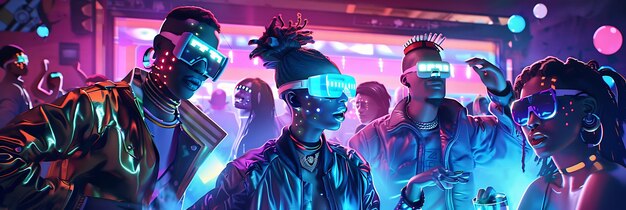
Digital Storytelling and Interactive Narratives
As digital technologies advance, so does the art of storytelling. We are witnessing a clear shift from passive consumption of narratives to highly interactive and personalized digital experiences. This trend, particularly strong in the US, spans various mediums, including interactive films, transmedia projects, advanced video games, and immersive web experiences. Digital storytelling leverages technology to create more engaging, non-linear, and participatory narratives that empower the audience to influence the story’s trajectory, profoundly changing the relationship between creator and receiver. This evolution highlights a move towards audience immersion and agency in cultural narratives.
The Evolution of Interactive Storytelling
Interactive storytelling is not a new concept, but digital platforms have amplified its potential exponentially. Early forms included “choose your own adventure” books, but today’s technology allows for sophisticated branches, multiple endings, and dynamic character interactions. This shift is particularly evident in video games, which have become masterclasses in non-linear narrative design, allowing players to shape the story through their decisions. Beyond gaming, interactive films and web series are experimenting with viewer participation, enabling audiences to make choices that impact plot points, character development, or even the overall tone of the narrative.
The beauty of digital interactive narratives lies in their ability to offer a unique experience to each participant, fostering a deeper sense of involvement and personal connection to the story. This contrasts sharply with traditional, linear narratives where the audience is merely an observer. By giving control to the audience, creators are able to explore complex themes and multiple perspectives in ways that were previously impossible. The technology behind this, including advanced scripting, AI-driven character responses, and sophisticated user interfaces, is continuously refining the art of weaving compelling stories across various digital formats.
Transmedia Narratives and Audience Engagement
A key aspect of modern digital storytelling is the rise of transmedia narratives, where a single story unfolds across multiple platforms and formats. This often means that different parts of a story are told through a video game, a graphic novel, an interactive website, a social media campaign, or even a live event, with each piece contributing uniquely to the overall narrative. This approach encourages deep audience engagement as individuals are compelled to explore different channels to piece together the complete story, fostering a sense of discovery and collaboration. It transforms passive audiences into active participants and even detectives.
- Platform-Specific Storytelling: Narratives are designed to maximize the unique capabilities of each platform, offering varied perspectives and experiences.
- Community-Driven Lore: Transmedia often thrives on community participation, with fans contributing to the story’s evolving lore through discussions and fan-created content.
- Expanded Universe Building: This approach allows creators to build vast, interconnected universes that extend far beyond a single film or book, offering rich, ongoing experiences.
The power of transmedia lies in its ability to create expansive, immersive worlds that transcend a single medium, enabling a richer and more layered understanding of the story. It represents a truly modern form of cultural consumption, where the narrative is dynamic, decentralized, and collectively experienced. As technology continues to evolve, these interactive and cross-platform storytelling methods will undoubtedly become even more sophisticated, allowing for unprecedented levels of immersion and cultural dialogue.
Preservation and Access: Digital Archives and Public Engagement
The digital age presents both unprecedented opportunities and significant challenges for the preservation of art and cultural heritage. In the US, there’s a growing recognition of the need to digitize, archive, and make accessible vast cultural collections, guarding against degradation and ensuring that future generations can access our collective heritage. Beyond mere digitization, new initiatives are focusing on innovative ways to engage the public with these digital archives, transforming passive viewing into active learning and participation. This involves leveraging advanced digital tools not just for storage but for interactive educational experiences and community-driven cultural exploration.
The Role of Digital Repositories and Archival Technologies
Digital repositories are becoming the backbone of cultural preservation, housing everything from ancient manuscripts to contemporary digital art. Advanced scanning techniques, 3D modeling, and high-resolution imaging allow for the creation of precise digital replicas of physical artifacts, protecting originals from deterioration and making them available to researchers and the public worldwide. Institutions like the Library of Congress, the Smithsonian, and numerous university archives are leading efforts to build comprehensive digital collections. These digital archives are not just static storage; they are dynamic resources, constantly being updated with new acquisitions and improved metadata for easier search and retrieval.
Moreover, technologies such as blockchain are beginning to be explored for archival purposes, offering immutable records of authenticity and provenance for digital artworks and other cultural assets. This ensures the long-term integrity and verifiable history of digital heritage. The development of robust digital preservation strategies, including migration to new formats and regular data integrity checks, is crucial for safeguarding these digital assets against technological obsolescence and data loss. This systematic approach ensures that America’s cultural legacy, whether born digital or digitized, remains accessible and meaningful for centuries to come.
Engaging the Public with Digital Cultural Heritage
Merely digitizing collections is only half the battle; the true innovation lies in how these digital archives are used to engage the public. Museums and cultural institutions are developing interactive platforms, virtual tours, and educational programs that bring historical artifacts and artistic masterpieces directly to people’s homes. Gamification, augmented reality apps, and virtual reality experiences are transforming how audiences interact with historical content, making learning more immersive and entertaining. For instance, an AR app could allow users to “place” a 3D model of an ancient statue in their living room, providing an intimate and manipulable view.
- Crowdsourcing Initiatives: Engaging the public in transcribing historical documents or identifying details in archival photographs, turning passive users into active contributors.
- Interactive Educational Platforms: Developing online modules and virtual exhibitions that cater to diverse learning styles, making complex cultural topics accessible to all ages.
- Open Access and Creativity: Providing open access to digital collections, encouraging artists, educators, and the public to reinterpret and create new works inspired by heritage.
This focus on public engagement transforms cultural institutions from mere custodians of history into dynamic centers of learning and community interaction. By harnessing digital tools, they can foster a deeper appreciation for heritage, encourage critical thinking, and inspire new forms of artistic and scholarly endeavor, connecting cultural heritage with contemporary life in powerful and meaningful ways. This democratic access to culture ensures that knowledge and inspiration are not limited by geography, economic status, or physical accessibility.
| Key Trend | Brief Description |
|---|---|
| 🌌 Immersive Experiences | VR and AR transforming art consumption and creation, offering interactive, boundary-breaking engagements. |
| 🤖 AI Generative Art | AI as a creative partner, generating unique art, challenging authorship, and expanding artistic boundaries. |
| 💎 NFTs & Decentralization | Verifiable digital ownership, direct artist monetization, and new forms of digital collectibles and communities. |
| 📖 Digital Storytelling | Interactive narratives across platforms, empowering audiences and fostering deep engagement with stories. |
Frequently Asked Questions About Digital Art & Culture Trends
The growth of digital art in the US is primarily driven by rapid technological advancements, increased internet accessibility, the ubiquity of digital devices, and a shift in audience preferences toward interactive and immersive experiences. Social media platforms and online communities also play a crucial role in disseminating and validating digital art forms.
NFTs are significantly impacting traditional US art markets by introducing verifiable digital ownership and empowering artists to bypass intermediaries. This creates new revenue streams and direct artist-collector relationships. While some see NFTs as complementary, others view them as a disruptive force, challenging traditional valuation and exhibition models.
The question of whether AI can be considered an artist is complex. While AI can autonomously generate technically impressive artworks, the definition of “art” often involves human intent, emotion, and conceptualization. Many view AI more as a sophisticated tool or a co-creator that expands the possibilities for human artists, rather than an artist in its own right.
Immersive art experiences face challenges such as accessibility due to the cost of equipment, the need for specialized technical skills for creation, and potential issues with motion sickness or user fatigue. Content creation also remains complex and time-consuming, though advancements are continually addressing these barriers to wider adoption.
The metaverse is poised to evolve cultural consumption by offering highly interactive, persistent virtual spaces for art, music, and social gatherings. It will enable global cultural exchange, personalized experiences, and new forms of digital entrepreneurship. This evolution could democratize access to culture and foster novel community-driven artistic ventures.
Conclusion
The digital art and cultural landscape in the US is a vibrant, rapidly evolving ecosystem characterized by continuous innovation and transformation. From the profound immersive experiences offered by VR and AR to the groundbreaking generative capabilities of AI, and the revolutionary ownership models introduced by NFTs, technology is not merely a tool but a fundamental driver of artistic and cultural expression. These trends are not isolated; they frequently intertwine, creating a tapestry of interconnected digital realms where creativity knows no bounds. As we navigate this exciting frontier, it becomes clear that the future of art and culture will be increasingly defined by our willingness to embrace digital tools, foster collaborative practices, and re-imagine what it means to create, share, and experience art in an interconnected world.
